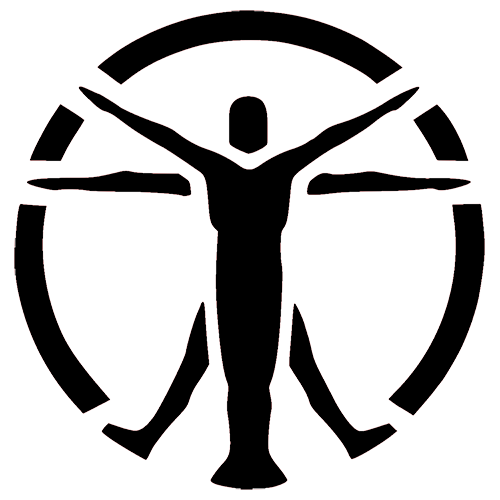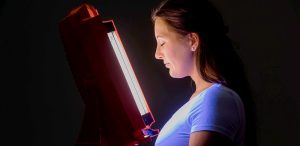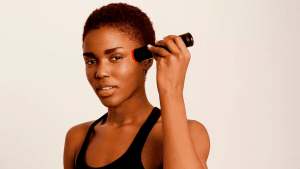Even though eczema is one of the most common skin diseases in the world, we often cannot fully understand whether light therapy helps with this, how it works, etc. There is a lot of information, but rarely when it is structured and written in simple language. We decided to answer the most common questions about asteatotic eczema and the effect of light therapy on it.
What is asteatotic eczema, how light therapy can help treat this disease, whether eczema treatment with phototherapy has side effects and disadvantages — read this and much more in our article.
What is asteatotic eczema?
Asteatotic eczema is a type of dermatitis that can be atopic or non-atopic and occurs as a result of dry skin [1]. It is also known as xerotic eczema. Anyone with dry skin can develop this type of eczema, but it most often affects older people. Low humidity, winter, desert, overuse of dehumidifiers or fan heaters, high altitude, frequent travel to different regions can cause asteatotic eczema too.
Typical treatments for eczema include applying emollients and moisturizers (petroleum jelly or oil cream), taking a bath occasionally, avoiding direct skin exposure to heat, etc. However, there is another working way to fight asteatotic eczema — light therapy. Its efficacy and safety have been confirmed by numerous clinical studies in this area.
How does light therapy help asteatotic eczema?
People who suffer from eczema and other types of dermatitis have a reduced barrier function of the skin, the largest organ in the body whose primary role is to protect against infections and toxins. In the picture below, we can see that in healthy skin, tightly packed dermis cells help create a natural skin barrier, while in eczema-affected skin, keratinocytes (skin cells) become less lightly held together. Scratching wounds damage skin cells, opening them up to infection and releasing chemical messengers that cause inflammation.

Red light therapy uses relatively long wavelengths of light (630nm to 700nm) to penetrate the skin and promote healing, increase circulation, improve skin tone, and treat all types of dermatitis and asteatotic eczema in particular.

This therapy works because red light increases the production of adenosine triphosphate (ATP) — the energy source of all cells. With an increase in ATP, skin cells have more energy for regeneration, and healing. Red light therapy also eases atopic dermatitis symptoms by increasing circulation for the skin, immune cell-activating that removes waste from the body, and stimulating DNA/RNA synthesis.
The effectiveness of light therapy in treating asteatotic eczema based on clinical trials
Multiple studies show that light therapy can effectively affect eczema — both atopic [3] and non-atopic dermatitis [2]. The visible results in the treatment of non-atopic dermatitis with light therapy can be seen in the picture below.

A 67-year-old female patient has had for 20 years recurrent moderate non-atopic dermatitis. The subject initially had pruritus, active vesicles, redness, and dryness in the popliteal fossa. After six weeks of UV-free light treatment, there was a significant improvement in overall well-being, and symptoms such as itching and redness of the skin had disappeared [2]. Redness on the palms and hands was also significantly reduced after the light treatment, which we can see in the picture below.

Light therapy reduces itching from the first week and maintains this effect throughout the treatment. A week after the end of treatment, redness and itching slightly increased, and general dryness of the skin also worsened, but this therapy should be done regularly for a certain time, which will be prescribed by the doctor to consolidate the result. However, this case study [2] aimed to evaluate the effectiveness of UV-free light therapy in a patient with chronic eczema. This trial demonstrated an overall improvement in symptoms with the least interference with the patient’s daily life.
Also, phototherapy can be one of the treatments for atopic dermatitis in older adults. You can see the results of clinical studies [3] of the treatment of eczema with different methods in the picture below.

b) 62 y.o. patient after 4 weeks ultraviolet phototherapy;
c) 66 y.o. patient after 1 year of dupilumab therapy
Compare: phototherapy has the best results with the least time and intervention in the patient’s life. After just 4 weeks of using ultraviolet phototherapy, the skin was significantly cleared of redness, and the patient got rid of itching. Thus, we conclude that narrow-band ultraviolet light in the correct dosage for each patient can be useful in the treatment of atopic dermatitis in adults.
The authors of another clinical study [4] concluded that ultraviolet phototherapy is one of the main treatments for hand eczema (along with corticosteroids). Irradiation with UV light can be performed with different types of UVA and UVB rays, depending on the wavelength. Ultraviolet A (UVA) has a longer wavelength and is associated with skin aging. Ultraviolet B (UVB) has a shorter wavelength and is associated with skin burning.
In general, UV light locally decreases the activity of the immune system and inhibits the number of inflammatory cells, thus relieving symptoms — redness, itching, etc. In addition, phototherapy increases the amount of stratum corneum: in other words, the skin gets thicker [4].
The results of this study [4] are as follows: a total of 18 trials were conducted for treating eczema in the hands — 10 studies with phototherapy, 3 with systemic immunosuppressants, and 5 with oral retinoids. 5469 participants with mild to severe chronic hand eczema took part in the study — most of them were over 18 years old. The duration of treatment was 4 months. In terms of ultraviolet (UV) light therapy for eczema, scientists have concluded that after 12 weeks of treatment, local combination ultraviolet light therapy (PUVA) may lead to improved symptom control.
Canadian scientists [5] have also conducted studies that have confirmed that ultraviolet phototherapy is one of the treatments for eczema. Since atopic dermatitis is almost the most common skin disease affecting an estimated 10% to 20% of Canadians, it is necessary to act in a complex manner. Doctors prescribe moisturizers and serums to patients, lifestyle changes, oral medications, and of course, UV phototherapy.
The results of this study [5] are that NB-UVB home phototherapy is at least as effective as NB-UVB phototherapy on an outpatient basis for treating mild to severe skin conditions such as psoriasis and eczema. In the included study, 82% of participants were treated at home, compared with 79% on an outpatient basis (many participants had experience with both). They showed an improvement in the baseline disease area.

Another research [6] has shown that light therapy can effectively relieve inflammation as well as other symptoms such as itching, allowing the skin to heal for a while. It can’t make eczema go away in the long term but will work great as an additional treatment along with the main treatment.
Also, combining light therapy with bathing therapy [6] has advantages: compared to treatment with UV light alone, bathing while being exposed to UV light can lead to a greater improvement in the condition of the skin, and reduce itching and sleep problems too.
Michelle, a young girl, was treated for eczema [7] for two months with phototherapy. Let’s take a look at the results in the picture below.

This is how the girl looked before the phototherapy. We see clear redness on the neck and the curves of the arm.

The bottom left picture was after the 2 months of phototherapy so you can see eczema was not 100% healed. The bottom right picture is Michelle the other day 100% healed [7].
Despite the apparent effectiveness of phototherapy, not every dermatologist prescribes this type of treatment. One of the main disadvantages for most people is time spent (road, waiting at the doctor, the procedure itself, etc). In this case, phototherapy can be used as the first step towards healing eczema.
Are there any side effects or disadvantages of light therapy affecting asteatotic eczema?
If you use ultraviolet light to treat eczema, you can feel burning, get minor burns or even blisters, but this can be avoided with the correct dosage of light therapy. Also, over time, signs of aging may appear — age spots, wrinkles, etc. While light therapy can be beneficial for some people, it may not be effective for everyone — especially for patients with extreme cases of skin condition. Doctors insist that in very severe cases, systemic biological or oral medications may be required, at least initially [8].
You should be aware, risks related to phototherapy include skin cancer and cancer. Exposure to UV light may result in skin cancer. The male genitals are highly susceptible to the cancer-causing effects of UV therapy. Also, the disadvantages of light therapy can be considered its cost: for insured patients, a co-payment may be charged for each time you receive treatment.
Another disadvantage is that it takes a lot of time and requires frequent trips to the doctor because you need to take procedures regularly to see the effect. If you do not live near the doctor’s office, you should consider the fact that you will spend a lot of time on the road, waiting for an appointment and the process of light therapy itself.
Summary
The search for the most effective treatment is the main goal of scientists and doctors around the world. One of the most successful methods in the fight against eczema and its types is light therapy — ultraviolet phototherapy, to be precise. It shows excellent results in reducing symptoms and getting rid of eczema in both older adults and younger patients.
However, before agreeing to this type of treatment, you need to consult with your doctor and carefully study all sorts of disadvantages and side effects of such therapy. If you have chosen phototherapy as your main treatment for eczema, know that light therapy has every reason to help you.
FAQs
🏆 Does LED light therapy help eczema?
Red light therapy can be an effective, natural treatment for eczema, reducing itchiness and inflammation, and helping speed the healing process of the skin in general. Scientific evidence, and before and after photos you can find in our article!
💪 How effective is phototherapy for eczema?
Both UVA and UVB wavelengths are used to treat eczema. Phototherapy is known to reduce inflammation in the skin, thereby affecting the immune system. Phototherapy improves the skin gradually after several weeks of regular treatments (2-3 times per week).
⌚ How long does LED light therapy take to work for eczema?
It may take one or two months of steady treatment with phototherapy to start to see improvement in eczema symptoms.
🌀 Does blue light therapy help eczema?
As shown by numerous clinical studies, the effects of blue light eczema and its types significantly reduce symptoms such as itching and insomnia. Thus, blue light can improve the quality and condition of the skin.
Sources
- Hon A/Prof Amanda Oakley, Dermatologist, Hamilton, New Zealand. Asteatotic eczema. – Updated online July 2014.
- Alberto Leguina-Ruzzi, Kishan Rajnikant Raichura, Sarah Karis Tonks, Semira Kwabi, Claudia Leitner. Treatment of non-atopic dermatitis with polarized UV-free polychromatic light: A case report. – Clin Pract. 2019 Aug 2; 9(3): 1161. Published online 2019 Sep 23. DOI: 10.4081/cp.2019.1161
- Ryoji Tanei. Atopic Dermatitis in Older Adults: A Review of Treatment Options. – Drugs Aging. 2020; 37(3): 149–160. Published online 2020 Feb 21. DOI: 10.1007/s40266-020-00750-5
- Wietske Andrea Christoffers, Pieter‐Jan Coenraads, Åke Svensson, Thomas L Diepgen, Janine L Dickinson‐Blok, Jun Xia, Hywel C Williams. Interventions for hand eczema. – Cochrane Database Syst Rev. 2019 Apr; 2019(4): CD004055. Published online 2019 Apr 26. DOI: 10.1002/14651858.CD004055.pub2
- Ontario Health (Quality). Home Narrowband Ultraviolet B Phototherapy for Photoresponsive Skin Conditions: A Health Technology Assessment. – Ont Health Technol Assess Ser. 2020; 20(12): 1–134. Published online 2020 Nov 2.
- Eczema: Light therapy and oral medications. – Created: February 23, 2017; Last Update: March 20, 2019.
- Michelle. Phototherapy to treat eczema: before and after pictures. – Purely Twins Blog
- Leslie Barrie. The Pros and Cons of Eczema Light Therapy. – Medically Reviewed by Ross Radusky, MD. Last Updated: February 17, 2021





